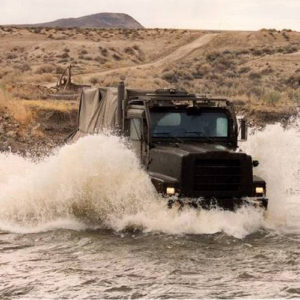 NATC’s unique water mobility tests include:
NATC’s unique water mobility tests include:
- Fording to 60 inches with cross current
- Swim
- Bank transition
- Simulated ship launch and recovery
- Shallow and deep fording with fresh or salt water
- Natural river crossings
Fording Facilities
We have both natural and man-made fording facilities. A river running through the proving ground offers natural fording with several depths and riverbed types.
Our saltwater fording trough is a 14-foot-wide by x 100-foot-long concrete base trough with 10% ingress and egress slopes. The fording trough can be filled with various controlled salt solutions to seawater conditions and the height of the trough is sufficient to allow water depths up to 60 inches.
Amphibious Swim Facility
Our swim facility provides customers with an inland demonstration facility that physically represents vehicle/vessel and vehicle/shore interfaces in an operationally relevant environment to further the development of amphibious vehicles. The facility is designed to support engineering level analysis and design validation focused on the interfaces.
This facility supplements our land test facilities that provide representative environments oriented on prototype and new platform development. It provides a controllable amphibious test environment for use in evaluating vehicle swim performance and lighterage interfaces early in the development process.
Facilities include:
- A modified powered floating causeway is used to represent ramp angles, heights, surfaces, and widths of varying vessel configurations including ramp configurations that are below the waterline, wet steel, and wood planking and the impact on ingress and egress The system can achieve more than 6 knots powered by twin 600 hp water jet drives.
- The 450’ x 450’ swim pond provides the controlled water body in which to evaluate vehicle swim characteristics before, during, and after the launch/recovery events.
- A set of beach gradients and materials provides shore transition zones in which to evaluate vehicle swim and mobility characteristics before, during, and after the beach transition events.
- The facility design has been defined by operationally relevant conditions in the following areas:
- Definition of bank conditions (slope, soil, vegetation, and infrastructure) representing the most likely and most severe operational environment anticipated.
- Definition of sand bar and reef events with variable soil strength, clearance below the water line, transition from partially submerged to fully submerged, etc.
- Specifications and dimensions of applicable lighterage ramps and decks necessary for evaluating lighterage/vehicle interfaces.